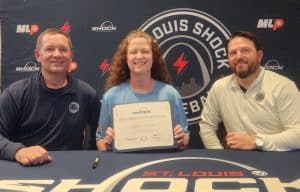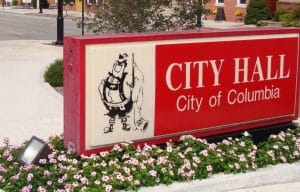Kueker bison statue unveiled outside courthouse
Passersby of the intersection of Mill and South Market streets in downtown Waterloo were greeted Monday by a stampeding bison at the northeast corner of the Monroe County Courthouse square.
The realistic statue took a circuitous path en route to its prominent display. Monroe County Board Chairman Delbert Wittenauer talked of the obstacles it overcame to travel from the late Col. Edmund Kueker’s front yard to arrive on a brick pedestal there during a Sunday afternoon unveiling of the statue.
“Col. Kueker offered it for permanent display sometime ago,” Wittenauer told an estimated crowd of 150 people, who started assembling at 2 p.m. for the 3 p.m. event. “But we were reluctant to start something that might begin an avalanche of people wanting to place objects around the courthouse.
“But those who knew Col. Edd know what a persistent person he was, and we finally relented. But, I told him, ‘you’re going to have to make all the arrangements, get the necessary materials, the labor and donations. We’re not going to spend a dime of county taxpayer money for this.
“Well, soon he had bricks from the old mill, then he rounded up people promising to contribute concrete, labor and money. The bison was going to have to be professionally refinished, and people stepped up to do that too,” Wittenauer told. “I also charged him to write a text for a plaque to explain why a bison was in our courtyard.”
Appropriately, Kueker’s wife, Violet, proudly read that plaque Sunday for all to hear.
“This is a magnificent tribute to him and a reminder of a segment of our history that we should never forget,” Wittenauer said.
OK. So what do bison have to do with Monroe County?
Emily Lyons, Randolph County Museum and Archives Curator, answered that question for the assembled audience.
“Bison roamed the prairies from the Appalachians to the Rockies for thousands of years,” she explained.
Part of that area was known as Illini Country in the 15th and 16th centuries, after the Native Americans who resided here.
“Father Pierre Marquette wrote in his journal documenting his passage through this region in 1673, of what he termed ‘cattle with a hump,’” Lyons said.
She told how the Native Americans and early settlers hunted bison for hides and meat. Little was wasted by them. They even used bones for tools and buttons, and sinews and intestines for bow strings.
And grazing animals, including the bison, made ways for humans to travel by trampling down tall prairie grasses and other vegetation as they regularly moved from place to place. One such path became what we are just rediscovering in recent years, the Kaskaskia-Cahokia trail, which a plaque by the Kueker bison notes was used by Native Americans and European settlers on foot, horseback and in wagons.
Today, that trail is roughly mirrored by Route 3 between the Kaskaskia River and Cahokia.
In the 1700s, thousands of bison were slaughtered, to be skinned, and their hides were sent down the Ohio and Mississippi rivers for sale to European buyers via New Orleans. Despite this wholesale harvesting, small herds remained in this area until the 1800s.
Lyons concluded her educational remarks, turning to the statue and saying, “After seeing the statue, I think it’s beautiful; the brickwork shows great expertise. The whole presentation is wonderful.”
Wittenauer said he was hesitant to give a list of people who contributed time, expertise and money, for fear of forgetting someone. But, noting a steel door in the back of the pedestal under the bison, he said that time capsules from each Monroe County community will be placed in there when the county celebrates its Bicentennial in 2016.
“In the county’s capsule, there will be a listing of all who gave, worked and pulled together to bring this effort to fruition,” he said. “If you can’t sign the roster today, it will be
in the County Commissioners office for you to do so. We don’t want to leave anyone out.”
Among those who helped on this project were Kenny Valentine and Julie Doerr, who painted the bison for its big day. The bison had to be restored, so Valentine started with the main stripping and first coats of paint with Doerr helping him finish it. Derrick Huebner also volunteered his time to help install the statue.
Wittenauer thanked Col. Edd and his wife for the bison and all they have done for the county and its citizens over the decades.
Telling the audience of the differences of opinion about where the Kueker bison should be placed, Wittenauer asked for a final vote.
“All who think it belongs here, raise your hands, please.”
It was unanimous. The bison was unveiled to loud cheers.
He is now home for good.County board meeting
On Monday, Monroe County Highway Engineer Aaron Metzger presented blueprints of the planned installation of an emergency generator to power critical activities at the courthouse in case of power outages.
While the plans are still flexible enough to accommodate necessary alterations, they are essentially complete. Metzger said he hopes the generator would be in place and operational for emergencies by this winter.
Metzger also reported that bids have been opened to start the Long Lake Road Bridge project, and he hoped to have a contract to present to the board for approval when they meet next on Aug. 18.
County Administrator Linda Lehr updated commissioners on work on the new website for the county. Wittenauer noted that the new site will include a search engine to assist users in finding information more readily.
The board also learned that Miles Cemetery, which previously announced it would soon be possible again for citizens to purchase grave plots, has in fact just sold two such burial plots.
This marks the first such sales in some 40 years, and is a milestone in return of the cemetery to full function after extensive efforts to clean it up and make it available to people wishing to reserve final resting places there.






